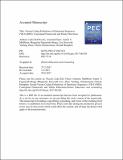Files in this item
Verona Coding Definitions of Emotional Sequences (VR-CoDES) : conceptual framework and future directions
Item metadata
| dc.contributor.author | Piccolo, Lidia Del | |
| dc.contributor.author | Finset, Arnstein | |
| dc.contributor.author | Mellblom, Anneli V. | |
| dc.contributor.author | Figueiredo-Braga, Margarida | |
| dc.contributor.author | Korsvold, Live | |
| dc.contributor.author | Zhou, Yuefang | |
| dc.contributor.author | Zimmermann, Christa | |
| dc.contributor.author | Humphris, Gerald | |
| dc.date.accessioned | 2018-06-21T23:32:16Z | |
| dc.date.available | 2018-06-21T23:32:16Z | |
| dc.date.issued | 2017-12 | |
| dc.identifier | 250299244 | |
| dc.identifier | 13ed3da0-baea-4278-a1bc-eee7023917ac | |
| dc.identifier | 85021405223 | |
| dc.identifier | 000415614000017 | |
| dc.identifier.citation | Piccolo , L D , Finset , A , Mellblom , A V , Figueiredo-Braga , M , Korsvold , L , Zhou , Y , Zimmermann , C & Humphris , G 2017 , ' Verona Coding Definitions of Emotional Sequences (VR-CoDES) : conceptual framework and future directions ' , Patient Education and Counseling , vol. 100 , no. 12 , pp. 2303-2311 . https://doi.org/10.1016/j.pec.2017.06.026 | en |
| dc.identifier.issn | 0738-3991 | |
| dc.identifier.other | RIS: urn:CB3FC25F04D143EC4779A78788102C2A | |
| dc.identifier.uri | https://hdl.handle.net/10023/14431 | |
| dc.description.abstract | Objective: To discuss the theoretical and empirical framework of VR-CoDES and potential future direction in research based on the coding system. Methods: The paper is based on selective review of papers relevant to the construction and application of VR-CoDES. Results: VR-CoDES system is rooted in patient-centered and biopsychosocial model of healthcare consultations and on a functional approach to emotion theory. According to the VR-CoDES, emotional interaction is studied in terms of sequences consisting of an eliciting event, an emotional expression by the patient and the immediate response by the clinician. The rationale for the emphasis on sequences, on detailed classification of cues and concerns, and on the choices of explicit vs. non-explicit responses and providing vs. reducing room for further disclosure as basic categories of the clinician responses is described. Conclusions: Results from research on VR-CoDES may help raise awareness of emotional sequences. Future directions in applying VR-CoDES in research may include studies on predicting patient and clinician behavior within the consultation, qualitative analyses of longer sequences including several VR-CoDES triads, and studies of effects of emotional communication on health outcomes. Practice implications: VR-CoDES may be applied to develop interventions to promote good handling of patients’ emotions in healthcare encounters. | |
| dc.format.extent | 833479 | |
| dc.language.iso | eng | |
| dc.relation.ispartof | Patient Education and Counseling | en |
| dc.subject | Communication | en |
| dc.subject | Emotion | en |
| dc.subject | Cues | en |
| dc.subject | Concerns | en |
| dc.subject | Sequence analysis | en |
| dc.subject | Clinical interaction | en |
| dc.subject | RA Public aspects of medicine | en |
| dc.subject | BF Psychology | en |
| dc.subject | BDC | en |
| dc.subject.lcc | RA | en |
| dc.subject.lcc | BF | en |
| dc.title | Verona Coding Definitions of Emotional Sequences (VR-CoDES) : conceptual framework and future directions | en |
| dc.type | Journal item | en |
| dc.contributor.institution | University of St Andrews. School of Medicine | en |
| dc.contributor.institution | University of St Andrews. Health Psychology | en |
| dc.contributor.institution | University of St Andrews. WHO Collaborating Centre for International Child & Adolescent Health Policy | en |
| dc.contributor.institution | University of St Andrews. St Andrews Sustainability Institute | en |
| dc.contributor.institution | University of St Andrews. Population and Behavioural Science Division | en |
| dc.identifier.doi | 10.1016/j.pec.2017.06.026 | |
| dc.description.status | Peer reviewed | en |
| dc.date.embargoedUntil | 2018-06-21 |
This item appears in the following Collection(s)
Items in the St Andrews Research Repository are protected by copyright, with all rights reserved, unless otherwise indicated.

